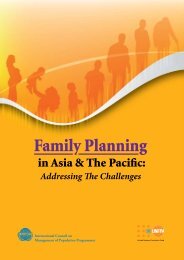Inter-lInkages between PoPulatIon DynamIcs anD DeveloPment In ...
Inter-lInkages between PoPulatIon DynamIcs anD DeveloPment In ...
Inter-lInkages between PoPulatIon DynamIcs anD DeveloPment In ...
Create successful ePaper yourself
Turn your PDF publications into a flip-book with our unique Google optimized e-Paper software.
young people. Therefore, the NSP aims to provide appropriate prevention,treatment and care especially to IDUs and their partners; women, youthand children; and marginalised and vulnerable populations.Other priorities include strengthening leadership and advocacy; trainingand capacity enhancement; and improving access to diagnostic,treatment and care to reduce HIV vulnerability among high risk orvulnerable populations.The AIDS/STD Section of the Disease Control Division of the Departmentof Public Health, MOH is responsible for the coordination of Malaysia’sHIV/AIDS response.…the epidemic has the abilityto reverse the developmentgains achieved. It is thereforecritical that HIV/AIDS isaddressed as a health issue butalso integral to nationalplanning.NSP on HIV/AIDS 2006-2010The National Action Plan for Employment in Malaysia 2008-2010The National Action Plan for Employment (NAPE) was formulated to address the employment challengesfaced - for example, increasing unemployment and underemployment; youth employment; heavy dependenceon foreign workers, fast changing labour market demands; high market demands for employees who arecompetitive internationally; and global competition and rapid change in the working world - with the objectiveto produce high levels of efficiency, competencies and inclusion that would promote jobs be created, takenup and sustained with greater ease by the Malaysians.The 10 strategies to address the challenges above are as follows:1. Active and preventive measure for the unemployed and the inactive;2. Promoting job creation and entrepreneurship;3. Promoting adaptability and mobility in the labour market;4. Promoting development of human capital and lifelong learning;5. Promoting active employment of older workers and the ageing;6. Strengthening gender equality in employment;7. Promoting labour market integration of disadvantaged groups;8. Making work pay;9. Transforming undeclared work; and10. Overcoming regional and sectoral employment disparities.For strengthening gender equality in employment, the major challenges identified are gender wage gap;horizontal segregation, in which women remain concentrated in a few occupations; and vertical segregation,in which women are unable to move up to higher positions. NAPE’s response to enhancing women’s employmentis to provide necessary support facilities such as introducing family-friendly workplace, establishing communitychildcare and nursery centres in housing areas; increasing education and training opportunities for skillsupgrading; and reducing discriminatory laws and regulations.The policies, including the strategic and action plans, have moved away from the conventionalfocus on the impact of population growth on development due to the nation’s declining TFR.The policies are in line with Vision 2020 which aspires for Malaysia to be a progressive andprosperous nation and in full possession of an economy that is competitive, dynamic, robustand resilient. The core emphasis is enhancing the standard and sustainability of quality oflife of Malaysians. Themes underscored are improved health, enhanced human capital interms of education and employment skills to compete globally, gender equality and povertyeradication. All these measures are likely to further accelerate the decline in TFR.Nevertheless, the framework needs to pay more attention to address issues–such asenvironment and international migration, especially migrant workers–on the nexus <strong>between</strong>population and development in the Malaysian context.18














